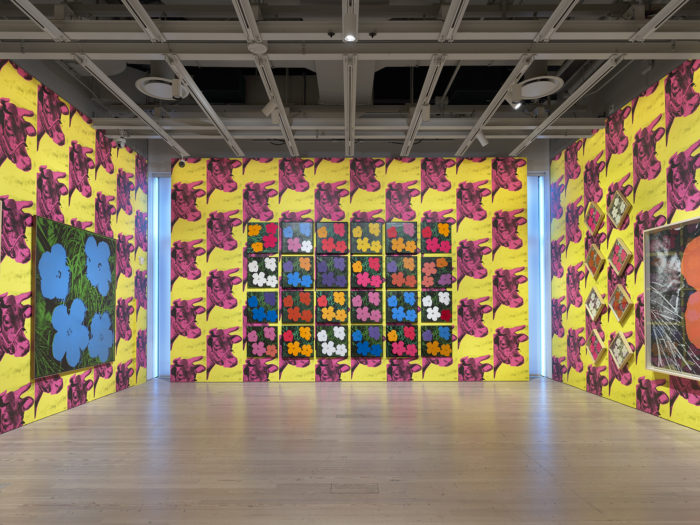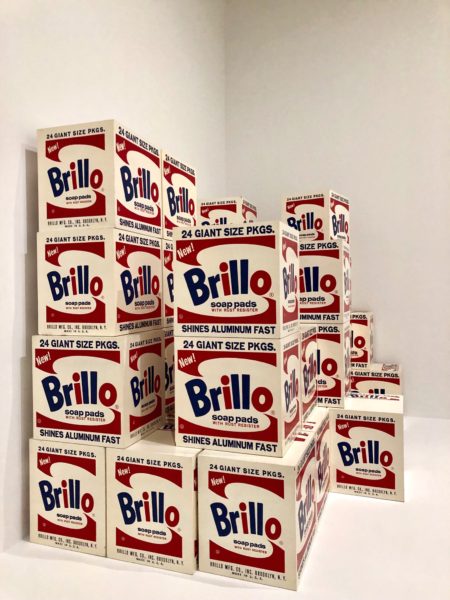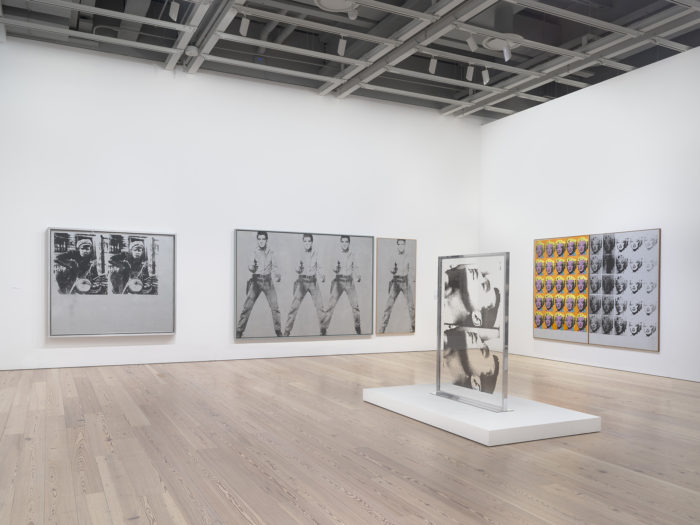
Although my students in art school don’t actively refer to him, Andy Warhol has changed the landscape of contemporary art so thoroughly, he exerts a cultural force that holds sway over their education and image environment. The change is obvious and permanent: contemporary artists and their audiences unconsciously–or consciously–demand to be entertained rather than edified. In addition to changing the aura of art made during his career and later, even now, Warhol also pushed the definition of art far beyond notions that preceded him. He did this without precedent, and his point of view has taken hold all over the world of art. At present, the notion of celebrity, both as a theme and a goal for the ambitious young artist, has become deeply rooted–likely, the result of his or her internalization, even without knowing, of images such as Marilyn Monroe, Jackie Kennedy, and Elizabeth Taylor. These works, heavy on glamor and casual charm, predispose the viewer to a visual currency of pleasure and fame–qualities that social media today has cemented into place. There is, in fact, a problem with the depth we usually encounter in Warhol–even his diehard admirers would likely acknowledge his penchant for skimming the surface. At the same time, he captured events as they took place, some of which did have depth, to the point of being tragic: witness his bleak silkscreens of the electric chair and German shepherd dogs attacking a black protester in Birmingham, Alabama.

It is becoming clear that the biggest change Warhol’s art brought about is our predilection for work that is, more or less, history-free. It is true he did make use of art-historical imagery–there are two repetitions of the Mona Lisa on the fifth floor of the Whitney–but that use pales in light of his presentation of current events and prominent socialites. In art today, our references to the past are ironic, perhaps even a bit resentful. We re-make famous paintings by incorporating identities and genders that were not brought into account in the past. As a result, art now lives in a continuous present, in which culture is not to be attained so much as it is to be enjoyed. No matter what anyone thinks about this–and arguments can be made for both ways of approaching culture–Warhol’s predilection for contemporary media maintains its prominence in the current art world. If one does take a critical view of his work, it is likely based on the feeling that imagery’s historical past has been erased in favor of an ongoing present moment, when the virtues of innovation and celebrity are to be preferred, even if their results are less than serious. It must be recognized, though, that from the start Warhol had his thumb on the pulse of the time. In this sense, no matter anyone’s misgivings, his fame is justified.
At the same time, we can question the consequences of his career. Jeff Koons, a direct result of Warholian influence, has issued in a deliberate banality; his “production values” may be high, but the content of his imagery is absurdly limited (he would acknowledge so himself). We are creating work at a time when focus and depth are being rejected; years ago, at Koons’s retrospective at the Whitney when it was uptown, the dominant feature of the exhibition was watching visitors taking selfies in front of his sculptures. The show was a celebration of the ego for the sake of everyone involved. It does little good to fulminate about the state of current image-making, but it can be said that Warhol’s vision has limited art’s reach to immediate pleasure. The show now on view at the Whitney makes it possible to see how the artist captured the spirit of America, buttressed by its fabulous wealth in the Sixties, when our point of view still held moral weight (when Warhol began his career as an artist, Vietnam was not yet an issue). This is a good time to see his work again, in large part because we have enough distance from it to read into it with some objectivity. And a measure of objectivity is what we need with Warhol, for his popularity is not necessarily the same as his achievement.

Looking at the Brillo boxes, accompanied by hundreds of other viewers, one feels obliged to read their present installation as a travesty of imitation. A strong argument has been made in favor of their active re-definition of what art can be, but in light of the young crowds on hand, their aura feels commonplace, nearly free of imaginative charge. Given the contemporary, immediate acceptance of anything as art, the boxes look like what they are: close copies of the real thing. Still, their philosophical effect, the promotion of an imagery rooted in everyday life, stays permanent. This transformation of the commonplace into a visual triumph of democracy occurs throughout the show–hence Warhol’s reliance on notable figures, made available, who could anchor his belief in the promise of the ordinary. The Brillo boxes remind us that, according to Warhol and our current view, any physical thing can be successfully turned into an art image; and that, moreover, the image’s consequences would be based at least as much on its worldly ubiquity as on its visual cohesion. In a way, then, the debate about their authenticity as art no longer concerns us; instead, they are (and always were) vehicles delivering an everyday sublime.
So, remarkably, in this show, the phrase is not a contradiction in terms. Instead, it restores us to the confident comfort of what we know. I have seen other Warhol shows over the years, and always the exhibition’s atmosphere is one of viewer gratification bordering on euphoria. Warhol made a triumph of out of American thinking and production–there is the famous story of his being convinced by friends to give up his ab-ex rendering of the Coke bottle for an exceptionally realist version of the container. Sadly, we no longer see the squat glass bottles of soda so much in real life anymore, but they survive in this show. Yet his objects of desire are beginning to age. Who would have thought that Warhol could become slightly quaint? This is what has happened, and it results from his reliance on things–and people–current at the time. The datedness also shows us that we have moved a great distance from the innocence of the Sixties, when prosperity was golden and seemingly more easily attained.
Still, it cannot be said that the mood the show engenders is elegiac; rather, it is supported by our continuing fascination with fame. Once again, we re-live with Andy the pleasures of popular recognition. His shoe advertisements remain fetching, and his portraits of famous people–his feminized Mao, his gloriously beautiful Elizabeth Taylor– exist in compositions made permanently attractive by bright color blocks. Determining whether the art is good or bad is irrelevant. The work is beyond evaluation, being descriptive of a social reality that takes precedent in our experience of the art. The absurdity of Mao being painted up like a woman reminds us that the Chinese leader’s politics were, even then, seen here as irrelevant at best–America’s individualistic materialism is worlds away from Chinese communal thinking. In Warhol’s hands, Mao looks like the butt of a joke–even more so now, when China is completely entranced by money. The portrait also reminds that Warhol was cheerfully unapologetic about his homoeroticism, an attitude now firmly established in contemporary culture. The viewer old enough to have been politically motivated when Warhol made his work will not find that much to remember; the artist celebrated party life and consumer acquisitions much more than he brought the violent thread of American society into play.

While Warhol emphasized the moment at hand, even he took brief notice of painting’s past. There is a large work, Sixty-three White Mona Lisas (1979), in which rows of the white icon build a long horizontal across the wall of the gallery. The image itself was not so easy to pick up in the bright light, reducing the picture to slightly changing abstract tonalities. While the homage is made, it is important to note that serial repetition dulls the impact of the painting, reducing it to a surface commodity (repetition will do that to any image made). In fact, such reiteration is central to Warhol’s quest: the democratization of culture. In Green Coca-Cola Bottles (1962), seven rows of green bottles of the soft drink line up on top of each other, along with an ornate, red version of its name in script beneath. The image is a triumph of mechanical reproduction, as well as being an open affirmation of popular culture. It is prescient at its extreme.
If it is, in fact, true that Warhol’s body of work is starting to age–he died more than thirty years ago–we can begin thinking about it as a piece of art history more than a leading-edge vision of lifestyle as art (This can be done even if we are still drinking Coke!). Worldwide, it looks like we are becoming a monoculture, with American popular culture continuing to lead the way; this has been happening for decades. Changing this looks pretty much impossible, given the ubiquity of the Internet. Warhol’s place now looks very secure; it did from the start of his career. Abstract-expressionism needed someone to cut through the rhetoric it operated with, and Warhol did it spectacularly, preceded by proto-pop artists Johns and Rauschenberg. He also developed a very large space for followers in which to make their own art, being taken with imageries of extreme currency and pleasure. Very few artists in the last hundred years have attracted so much affection, but his detractors remain adamant about the lack of depth. It has to do with the shift in visual culture from something often historically based on something experientially driven.

But Warhol knew that he had to forge his own past intuitively, early on. Triple Elvis (Ferus Type) (1963) looks like an attempt to start a new iconography, based on movie images. The triple image of Elvis, wearing cowboy clothing and holding a pistol, is a self-originating trinity; given the singer/actor’s history, he is a Christ for our time. But the picture is heavily commercial; it was a fantasy to be bought before it was realized. Warhol’s serene theft of the film still is not ethically questionable, imagistically speaking, but it posits a history that began yesterday. That is his point–we must embrace what began the day before. But if we do that, we forget actual history–some 16,000 American troops were present in Vietnam in 1963, promulgating a military involvement we have done our best to forget. An over-reliance on literal imagery without a past is likely how Warhol might be criticized. It leads to a cul-de-sac, in which nothing metaphorical can exist because of the artist’s emphasis on the thing itself–there is no travel from one imaginative space to another. So we stand still, without motion. By giving us Elvis three times, Warhol substituted repetition for metaphor, advancing his idea that in a post-industrial, consumer democracy, sameness is a high virtue. He does so on a regular basis.
So reiteration and sameness are central to Warhol’s esthetic. Even the Mona Lisa receives this treatment. In doing so, Warhol evens out art history, to the point where there is no difference in culture or achievement. It has the virtue of advancing the image to a general public in a contemporary manner; it has the drawback of reducing the image to a commercial quotation (we remember that Warhol began his career as a shoe illustrator). As time has moved on, we have turned more and more to a self-perpetuating literalism, which supports an exalted view of the self. Warhol likely had little or no idea what his advocacy of consumer democracy would become, but he was highly confident, even during his own time, about the attractiveness of expenditure and stardom. Because an image can be internalized without much effort, in a time when someone like Koons is promoting “easy fun,” Warhol’s view of fine art has risen to the top.
To summarize: this nicely presented exhibition makes it clear that Warhol’s popularity does go on unabated. He saw, more clearly and before anyone else, that fine art needed to be re-worked in a way that would accentuate its accessibility rather than its distance from a general public. As a result, he brought to the fore a real sense of what it means to be a contemporary person–specifically, a consumer in love with notoriety. As an American, he addressed our culture with the acute recognition that the purchase of things and the pursuit of celebrity could form the basis of contemporary art. His position has gained acceptance to the point where his visual language, based on advertising, famous people, and movies, is taken for granted. Now that visual culture is truly a part of the mainstream, Warhol’s point of view has gained prestige as well as approval. It should be remarked, though, that viewers who do not adhere to Warhol’s casual virtues will not be changed by this show, which examples nothing new. The virtue of this artist, even before he passed away, is that nothing changes in his art. It is self-similar to an extreme degree, but it is also reassuring to those among us–most of us now–who want to see what we know, preferring doing so to waiting for the unpredictable.
Andy Warhol— From A to B and Back Again at The Whitney Museum of American Art
Nov 12, 2018–Mar 31, 2019
-Jonathan Goodman
